How to overclock a card with msi afterburner. Instructions for using MSI Afterburner
Program MSI Afterburner is one of the most common utilities for overclocking video cards. This program can be used to change core and memory frequencies in order to increase or decrease hardware performance. This is especially true if the user is working on an old laptop or personal computer, the video adapter on which is not integrated.
After all, many have asked questions like how overclock nvidia video card or amd radeon on a laptop or personal computer. This is the question our article addresses.
Overclocking program nvidia video cards/ radeon (as well as other manufacturers) can be divided into several functional modules - basic and additional. The main functions include a section for changing available parameters video cards, checking and testing will be possible after installation additional component – MSI Kombustor.
Additional functions of MSI Afterburner allow you to monitor the status of the adapter in real time (the ability to determine the temperature of the video card processor is available). It is possible to save screenshots (take screenshots), as well as capture part of the screen to record video.
In the main window MSI programs Afterburner contains the main elements for working with video card parameters. Here you can see core frequency, memory frequency, cooler speed, temperature and power consumption. For some types of video cards, not all parameters are available for changes, since manufacturers initially block them so that users do not have the opportunity to overclock video cards themselves using utilities based on commercial considerations and security issues. Also, on the control screen there is extra menu, from which you can get to additional settings, where you can change the cooler rotation speed.
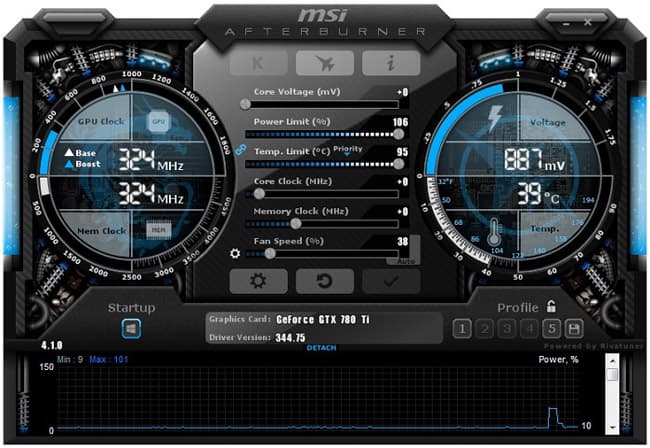
When installing MSI Afterburner in Russian, a utility called RivaTuner Statistics Server. It is used to display various characteristics of the video card on the monitor screen in the form of a Windows widget, regardless of what application is open in this moment. For example, we can observe the change in the FPS parameter directly on the monitor screen during the game (that is, in full screen mode games).
Attention: it is not always possible to overclock a video card using this program. And this is not the developers' fault. Here, video card manufacturers play a big role, for whom it is not profitable for users to overclock them themselves. They can always release the same model in overclocked form, as Nvidia often did. But, as practice shows, many models can be overclocked, the main thing is to know how to do it correctly and without damaging the computer. Well, the msi afterburner program itself can be downloaded from the official website or from ours, which is easier and more convenient. The latest version is available in Russian.
Features of the overclocking program:
- efficient work with video cards from different manufacturers;
- online monitoring of the video card using large quantity parameters;
- to change the characteristics of the video card there is no need to reboot and enter the BIOS;
- friendly and clear interface with detailed tips for each element;
- functions for documenting the operation of the video adapter - working with screenshots and recording video from the screen;
- individual settings- the user can customize the program for himself by changing the scale, time format, appearance interface and even application language.
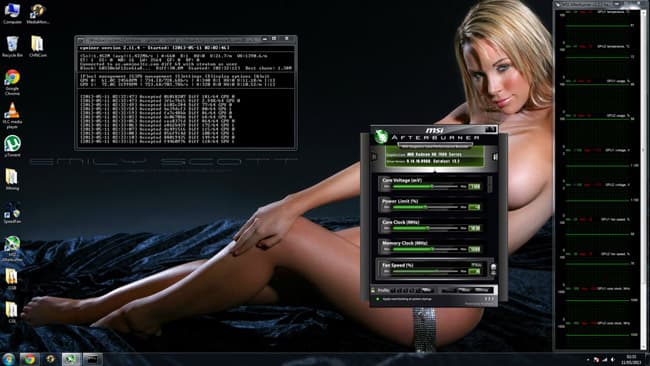
However, it should be noted that there are shortcomings in the program.
MSI Afterburner has several functional nuances that may affect the further performance of the overclocked video card:
- it is impossible to know the limit of the video card's capabilities;
- When overclocking, there is a high probability of system overheating when insufficient cooling, which can lead to spontaneous shutdown computer or to constant reboots.
In addition, a few words from an expert: when working with the program, the RivaTuner utility turned out to be a pleasant addition Statistics Server. It allows you to monitor system status in full-screen applications and games. An important point is to monitor the cooler temperature, especially when the system is experiencing high loads. Regarding the MSI Afterburner program itself, the developers tried to make the interface as user-friendly as possible so that users could quickly understand a huge amount settings, all buttons have tips for quickly understanding their functionality. It is a little unclear why the MSI Kombustor component was not initially included in the program. The MSI Afterburner interface has a button to launch Kombuster.
Apart from this small drawback, latest version programs for overclocking video cards MSI Afterburner is a good alternative to others similar programs(Russian language support available). It can be used for testing and overclocking video cards, monitoring parameters, taking into account the possibilities for further documentation. In addition, the program has in its rich arsenal functions for capturing video, which serves as an alternative free program Fraps.
| SCREENSHOT: | TECHNICAL INFORMATION: |
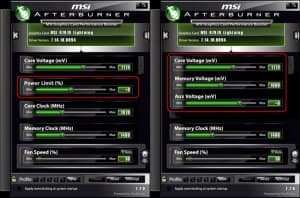 |
The first thing to consider when overclocking a video card is its cooling. This is especially true for running the most advanced video games, which create a tremendous load on the video processor. If you have a weak cooler on your video card, or no cooling means at all, then think twice before overclocking the hardware. We also do not recommend overclocking video cards in laptops. Almost any specialist service center will confirm that the number of cases of video cards burning out after overclocking is much higher in laptops than in desktop PCs with an average cooling system. Plus, not all cards support overclocking.
In addition to the above, it is worth considering that not all games use up the resources of the video card to the fullest. For example, in StarCraft 2 the main load goes to the processor. And a significant increase cannot be obtained by overclocking the video card. Therefore, it is worth carefully studying the features of the game (or program) for which you are going to overclock the card.
Experienced users try to overclock only old video cards with a good cooling system, when the problem of buying a new graphics processor is already brewing. Therefore, they will not be very sorry if their old card cannot withstand the new load. MSI Afterburner can also be used to lower the parameters to reduce average temperature video card and extend its life.
Process
We will overclock using the MSI Afterburner utility. We don't need to log in BIOS settings and change the voltage, as is done when overclocking a processor. Everything is done programmatically.
The overclocking process itself is as follows: we gradually increase the load on the video card and see how this is reflected in games. If we suddenly notice artifacts or unstable work, then we immediately return to the previous parameters.
Also suitable as a testing tool special programs(3DMark, FurMark, Video Card Stability Test and others). Plus, many players pursue the goal of achieving more High Quality graphics in those games that they ran on low or medium settings. Therefore, productivity gains can be tracked there too. On average, it is 15-20%.
Let's start overclocking.
Step 1. Settings
We launch the program (launch file – MSIAfterburner.exe) and see home screen, where in the graph Graphic Card our video card is indicated. IN in this case This Nvidia GeForce GTX 550 Ti.
A little higher we will see a gear icon. This is the Settings menu, and next to it is a reset button. Let's go to the menu.
![]()
In the “Select a Master GPU” column (the “Basic” tab), the video card for overclocking must be specified. If you have 2 video cards (discrete and regular), then the “Synchronize settings of identical GPUs” option must be enabled.
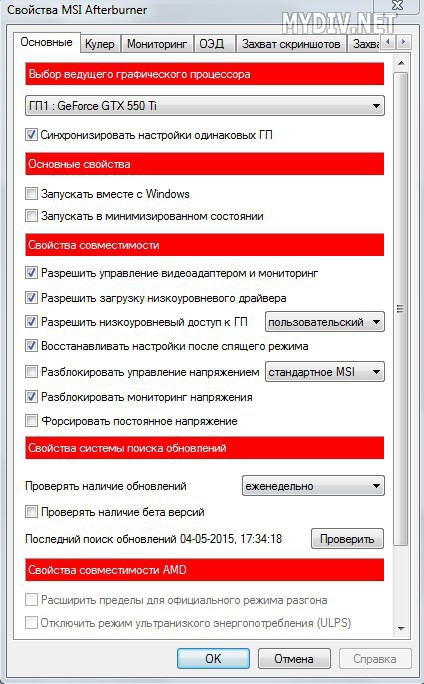
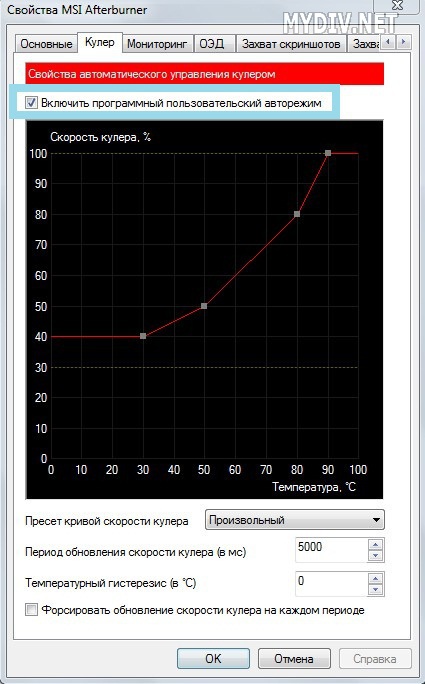
In the “Cooler” tab, set “Enable software user auto mode”. Now we can set the relationship between the fan speed and the temperature of the video card.
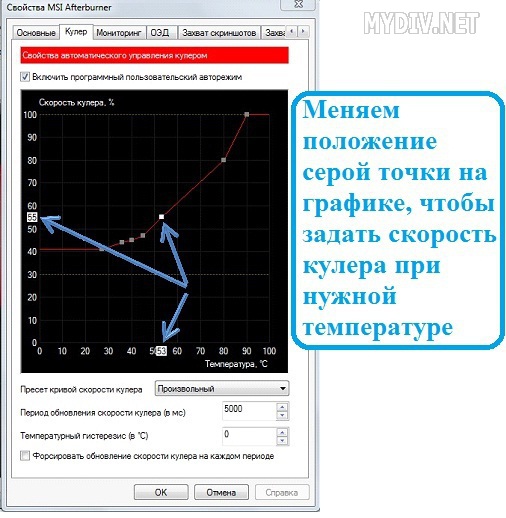
By changing the position of the points on the graph, we set the temperature and speed of the cooler at this temperature. You should not set the speed to 100%, otherwise the cooler will become unusable.
Step 2: Sliders
We will not touch voltage, power consumption and temperature.
Leave the value Fan Speed to Auto. In our case – 30%.
We need Core Clock(core frequency) and Memory Clock(video memory frequency). Their meanings vary depending on the video card model.
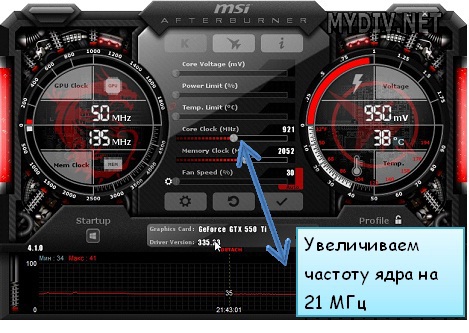
Move the Core Clock parameter slider to the right to 10-21 MHz and click the “Apply” button.
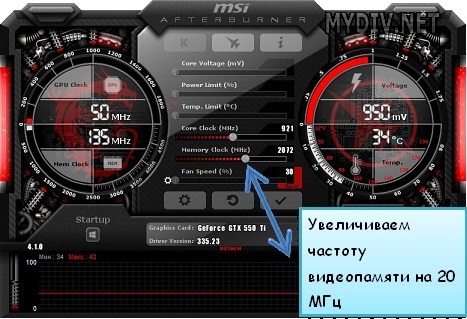
Similarly, move the Memory Clock slider to 10-20 MHz and click the “Apply” button.
As a result, at the first stage of increase we get the numbers 921 and 2072 MHz.
Step 3. Testing in games
Without closing MSI Afterburner, we launch a powerful game in windowed mode. The term “powerful” is relative here. Of course, Crysis 2 or 3 is best suited, since there the load goes more on the video card than on the processor. We play for 2-2.5 hours, simultaneously observing the temperature graph. If you do not notice any distortions (multi-colored flickering) or anomalies (red stripes on the sides of the screen), then you can further move the sliders to 10-20 MHz.
That is, the next stage of increase in our case will be 941 and 2092 MHz. After that, we run the game again for 2 hours and carefully monitor the artifacts. We repeat the procedure again.
When you have reached the limit of your video card's capabilities - screen distortion has appeared, then immediately close the game and lower the frequencies by 10 MHz. Let's check again. If the game is on stable, then we leave these parameters alone. If not, then we reduce it to the optimal state.
To monitor FPS (number of frames/sec.) in the game we have a program RivaTuner Statistics Server, which is installed with MSI Afterburner. We launch it (RTSS.exe) and set the value On opposite the option Show own statistics. Then in any game FPS will be displayed in the upper left corner purple. Learn more about how to display everything important parameters video cards directly in the game You can read in the guide “How to use MSI Afterburner”.
It is difficult to say at what stage the video card will receive a real performance increase. But if already at the 2nd or 3rd increase the temperature has increased sharply, then it is better to stop the process. The video card will survive overclocking, but within long-term use under high temperature it may burn. Therefore, it is very important to ensure in advance high-quality cooling. Under no circumstances should the temperature rise above 90 degrees!
Step 4. Stress test
If you don't have it on hand powerful games, then you can use benchmarks and hardware tests. Download the MSI Kombuster utility from the MyDiv website, install and open it through MSI Afterburner (K button) before overclocking.
During testing, FPS, temperature and total load video cards. Record this data. After the 1st stage of overclocking, we run this test again and observe the numbers. It’s worth saying right away that in games the performance increase is displayed more clearly than in similar tests. Similar to gaming testing, artifacts and distortions may also appear here. If you noticed such things even before overclocking, this means that there are very serious problems with the video card.
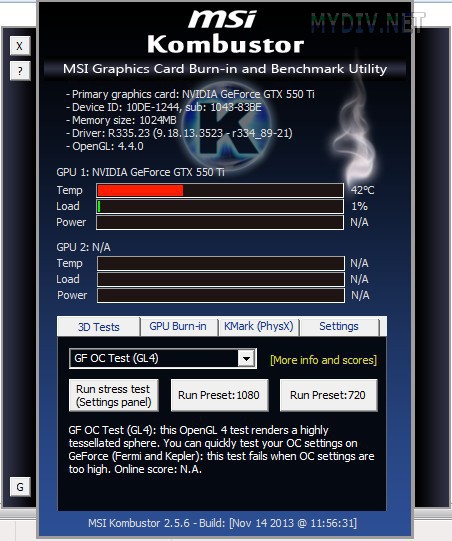
If just one stress test is not enough for you, then you should open Kombuster through executable file(C:\Program Files\MSI Kombustor 2.5\MSIKombustorDX11.exe). Above we will see the characteristics of our video card. GPU1 shows current temperature, loading and power consumption. In the 3D Tests, GPU Burn-in, KMark (PhysX) and Settings tabs you will find a variety of tests using complex 3D objects.
- GTX 1070 Ti for the price of a regular 1070 in Regard "> GTX 1070 Ti for the price of a regular 1070 in Regard
- GTX 1070 Gigabyte WindForce is also mega cheap
- iPhone 7 - sale in Citylink. Look at the price!
You can mark fragments of text that interest you,
which will be available at unique link V address bar browser.
About the benefits of overclocking. Part three - overclocking the video card
10.06.2011 03:55 Page: 1 of 3| | print version | | archive
- Page 1: Introduction, MSI AfterBurner, stability testing
- Page 2: Check-2, participants and overclocking, Inno3D GeForce GTX 480 iChiLL, Inno3d GeForce GTX 460, Gainward GTX 550 Ti GS
- Page 3: AMD Radeon HD 6870, AMD Radeon HD 5850, additional information, stand, performance, conclusion
Introduction
This article is written for overclocking beginners. Its purpose is to consider “regular” overclocking of video cards, which does not involve replacing the cooling system, increasing supply voltages or flashing the BIOS. In general, such overclocking of video cards consists of increasing the frequency of the core and video memory.
- The frequency at which all GPUs of a given revision (except for defective ones) will be able to operate - this means that some of them can actually work faster;
- The value of the video card core supply voltage (Vgpu) is optimal in terms of the ratio of GPU operating frequency and heat dissipation (uncharacteristic for top-end video cards);
- The level of heat generation (and therefore Vgpu, which also limits the GPU frequency) corresponds to the performance of the standard cooler used to cool this video card model.
Increasing the video memory frequency primarily depends on identical graphics core factors. But if Vgpu on video cards is set within the recommended values by NVIDIA and AMD, then the situation with the value of the video memory supply voltage (conventionally denoted as Vmem) is somewhat different. Memory from different manufacturers and different batches can be installed on the same video card model. Then Vmem can fluctuate within relatively significant limits, as a result of which there are often cases when the voltage across it is less than that recommended by the manufacturer. However, it also happens the other way around, when Vmem initially actually exceeds the recommended level.
The basic prerequisites for overclocking video cards are the same as For central processing units And random access memory : not all copies within the same family are overclocked equally; for successful overclocking you will need good cooling and a high-quality power supply, the final level of overclocking will also depend on the magnitude of the supply voltages. But, unlike processors and RAM, video cards are predominantly overclocked not with using BIOS, but by programs.
It is most convenient to control frequencies, pipeline formula, number of active vertex processors, and so on GPU-Z program(a kind of analogue of CPU-Z for processors):
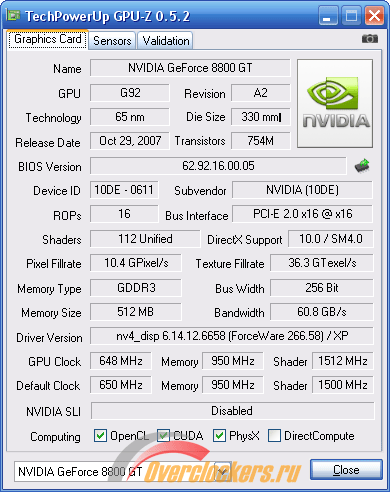
Overclocking of video cards is carried out by such programs as MSI AfterBurner, Sapphire Trixx, Riva Tuner, Ati Tray Tools, Power Strip and others. The most common one at the moment is MSI AfterBurner.
MSI AfterBurner
It is the successor to RivaTuner and allows you to overclock all modern (and not so modern) video cards. For a novice overclocker, its capabilities will be more than enough.
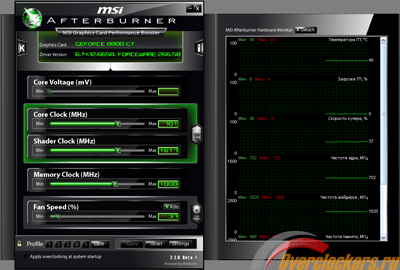
In order to switch the program interface from English (set by default) to Russian, click the “Settings” button in the lower right corner of the main program window. IN top line In the tab that opens, scroll to “User Interface”, then select Russian and restart the program. Unfortunately, the main program window will still remain in English.
Acceleration is carried out by moving the “sliders” to the right to the desired frequency value and then pressing the “Apply” button.
The main settings are hidden under the same “Settings” button.
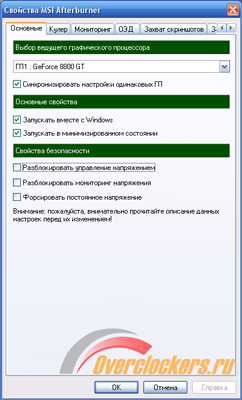
Synchronization of settings of identical GPUs ( GPUs) allows you to simultaneously overclock all identical GPUs installed in a PC when using SLI or CrossFire configurations. The purposes of the next two settings are clear from their names. Unlocking voltage control allows you to adjust Vgpu values on many video card models. Activation of voltage monitoring “speaks” for itself. Forcing DC voltage allows you to raise the Vgpu value in 2D mode to the 3D level.
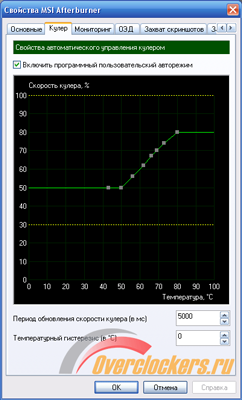
In the “Cooler” tab, when you enable software user mode, you can set a curve for changing the fan speed depending on the temperature of the video card core. The shape of the graph can be arbitrary - it is generated by the user by clicking the left mouse button. By default, the rotation speed is read every 5 s (5000 ms). Temperature hysteresis determines the difference between temperatures “A”, at which, according to the graph, the previous change in rotation speed occurred, and “B”, at which the next one should occur.
So, for example, if the fan starts to increase speed at a temperature of 60 degrees Celsius, then with a hysteresis value of 5, the speed will decrease only after the temperature drops below 55 degrees.
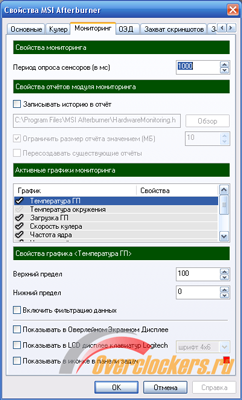
The meaning of most of the settings in the “Monitoring” tab is clear based on their name. Let us only clarify the purpose of the lower block of options.
Enabling data filtering allows you to minimize errors in reading data from sensors in the case of simultaneous use of several monitoring applications. If you have a Logitech keyboard with a built-in LCD screen at hand, then the entire necessary information can be brought to it. If you want to see the required parameters in the so-called “tray” window (in the lower right corner near the clock), you need to select the appropriate option.
We will pay special attention to the OED - overlay screen display. This feature allows the user to monitor the state of the video card in real time in 3D applications.
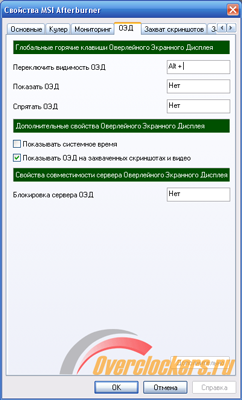
In accordance with the specified settings, the required parameters are displayed on the screen: GPU temperature, ambient temperature, GPU load, and so on in the list. When you click on the “Advanced” button, additional settings will be available:
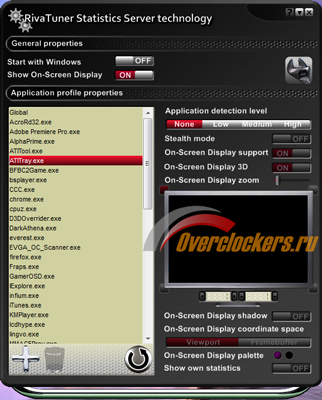
In the “Screenshot Capture” tab, you can configure hotkeys, format and location for saving screenshots.
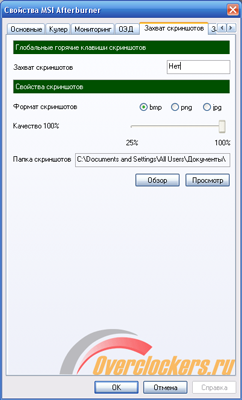
By analogy with the previous tab, video capture parameters are configured.
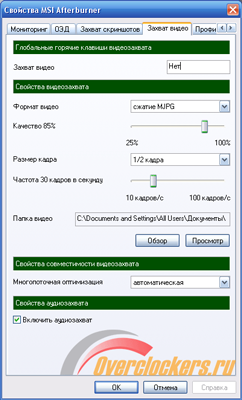
The next tab is for setting up profiles.
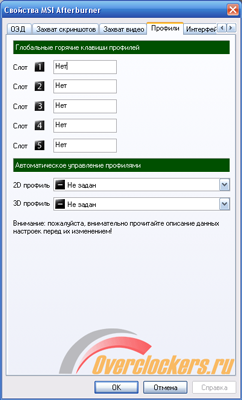
There are few interface settings: language, skin and display of interactive tips.
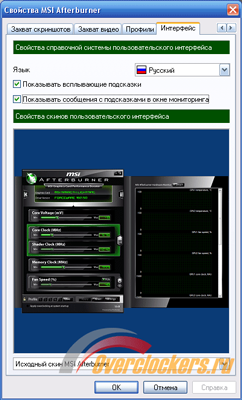
When you click the “Detach” button in the main program window, the monitoring window with graphs is disconnected. To return it to its place, you need to click on the right top corner window close button.
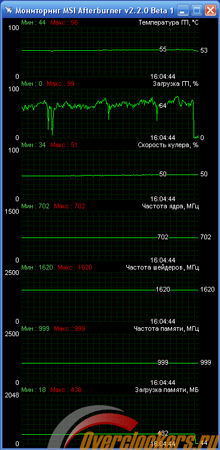
During acceleration Radeon video cards 5850 turned out to be impossible without additional settings programs to overclock the video card core to more than 775 MHz - “slider” GPU overclocking I just didn't move on.
To increase the frequency limit of the program, open the MSIAfterburner.cfg file located in the program folder in Notepad. Find the following lines in it.
Everyone knows that in addition to the processor, the video card can also be overclocked. At the same time, few people understand this issue and most have only a vague idea. As a rule, a video card contains elements such as microcircuits, a processor and a cooling system, which can be overclocked. Of course, this kind of action is still primarily performed on memory and the video core.
Before answering the question “how to overclock a video card?” It should be understood that the level of overclocking depends on the system components, for example, on the type of processor, cooling system and, first of all, on electrical supply. You should also take into account that overclocking Radeon video cards is the most popular among overlockers, since video adapters of this brand are easily amenable to such manipulations.
Why do you need to overclock a video card?
- Increasing the performance of the video card to, for example, get better display graphics in the game.
- Saving money, since a cheap video adapter can match the technical characteristics of more expensive models.
- Eliminate a weak point in your system, that is, all components respond high level, and the video card is the “weak link”.
- Feeling of excitement when you try to achieve maximum characteristics and you risk burning out an important element of the system.
- The feeling of being part of the overlocker community, which definitely raises self-esteem.
What are the dangers of overclocking a video card?
When starting to overclock a video card, you must remember that this process can lead to a reduction in its service life. Although modern video adapters are different large supply and are designed to last for several years. In this case, for example, an increase in the operating frequency can in no way significantly affect the life expectancy of the video card.
To a greater extent, the decrease in service life occurs when you experiment with voltage parameters. Therefore, in this case it is necessary to know not only specifications adapter, but understand the correctness of the overclocking process, that is, observe the safe voltage limit.
Warning: All actions aimed at overclocking the system are not covered by the warranty, so use all the tips below with full understanding and caution. Additionally, due to driver and GPU firmware limitations, overclocking some laptops may not be feasible.
Some advanced users probably know that in addition to excellent graphics hardware, MSI gaming solutions are equipped with the best GPU overclocking software, whose name is Afterburner. This application has been bundled with MSI graphics cards for many years. Afterburner is very good tool to overclock the clock speed of the GPU core and video memory. For some configurations, Afterburner even allows you to raise the core voltage and increase the maximum power factor. Moreover, this great tool for detailed monitoring of GPU parameters and status. The application offers the user more than 20 parameters for real-time control.
Afterburner v4.1.0 for mobile video cards GTX900M series
Afterburner works great on mobile platforms with some caveats for certain GPUs.
On most MSI gaming laptops (with GTX900M and GTX800M graphics cards), the application runs quite stable. Suitable version Afterburner for overclocking GTX980M, GTX970M, GTX965M and GTX950M mobile graphics cards is v4.1.0.
In this article we will try to overclock GE62 with Intel processor Core i7 4710HQ and GTX965M video card. Original base frequency GPU – 924 MHz; during gameplay it can rise to 950 MHz.
Using GPU-Z we get detailed information about GPU. The GTX965M has GDDR5 video memory with a frequency of 5000 MHz, which is obtained thanks to a 4x multiplier of the base frequency of 1250 MHz. However, if DDR3 is installed, the multiplier will only be 2x.
pay attention to lower limit indicators in the “GPU Clock” column. This is the standard GPU base frequency at which the core runs in currently. When we change the GPU frequency, the number in this field will change to the one we set.
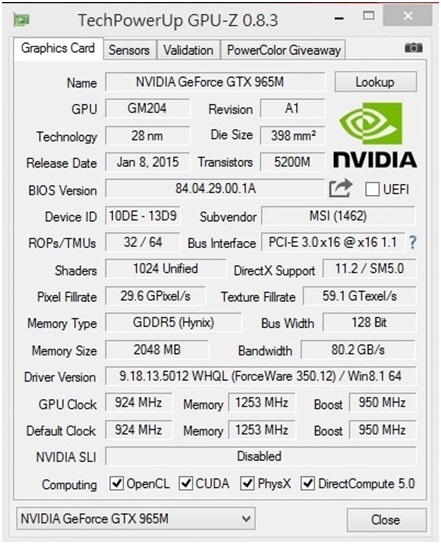
How to increase the frequency of the GPU and video memory
Afterburner will hardly raise any questions even in the hands of a novice overclocker. Just follow the steps we describe in this article and you will succeed.
When you launch Afterburner, the window illustrated below will open. For overclocking here, you will have access to only two parameters – GPU frequency and video memory frequency. These restrictions are due to the fact that mobile video cards changes to the core supply voltage, power factor limit, and fan speed are locked for the user. Therefore, we can only be content with these two parameters.
The GPU clock speed can be raised to a maximum of 135 MHz, while the memory frequency can be overclocked to 1000 MHz and above. But it should be remembered that when you approach the maximum capabilities of the system, it begins to work unstable. Moreover, it becomes unsafe. Here, just as an example, we slightly raised both figures by 120 MHz. Don't forget to click the “Apply” button to confirm your changes.
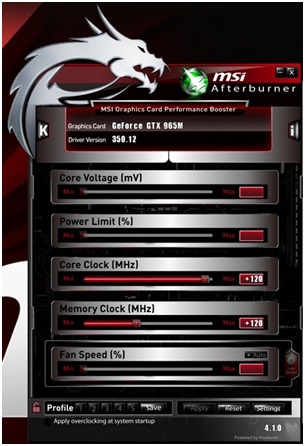
Next, we need to look at real-world performance and make sure the system works with the new settings. To do this, we used 3D Mark 11 - the easiest way to observe the difference in performance before and after overclocking.
In 5 minutes of testing at standard settings we got P7103 points.
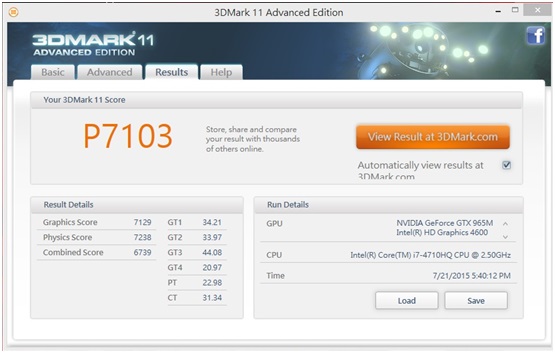
Before we run the 3D Mark 11 performance test again, we'll tell you one trick that will allow you to save overclocking parameters. First you need to change your desired overclocking settings. In our case we raised clock frequency GPU and memory at 120 MHz and applied the changes. Next you select Profile 1 and press Save button to save settings in this slot. As you can see, the user has 4 slots for saving parameters. In the future, everything you need to fast switching graphics card in one or another overclocking mode, this is to select one of the saved profiles.
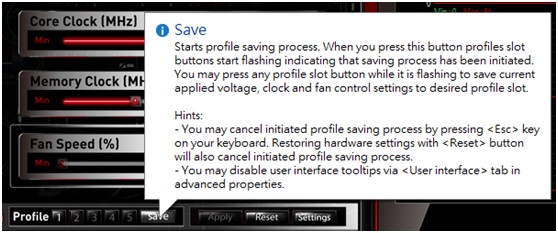
Now let's look at the results. When the GPU and video memory frequencies were raised to 120 MHz, the system remained stable, and the 3D Mark 11 performance test showed P7728 points. In the DirectX11 3D test in P-mode, the performance increase was more than 8%. 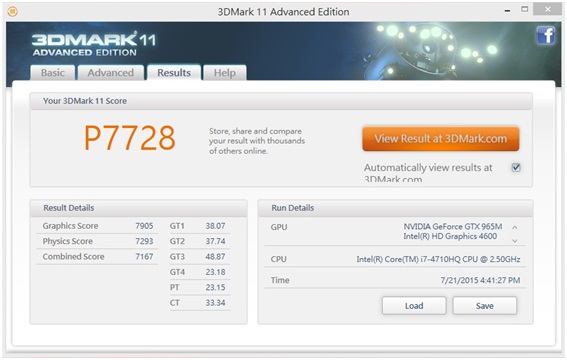
Real changes in games
Let's launch some heavyweight and see the real, applied nature of the changes. Our choice fell on the most popular action movie with tons of modernized weapons - “Call of Duty: Advanced Warfare”, which was recognized as one of best games in the “FPS Games of 2014” rating. With standard video card settings, we see a frame rate of 43.4 FPS, which is quite enough for combat scenes. ![]()

Now we launch Afterburner and raise the GPU and video memory frequency to 120 MHz. Next, we return back to the game and watch FPS on the same scene. As you can see, the frame rate has increased to 50.1 FPS, which is 15% higher compared to standard settings.
Thus, we are convinced that overclocking produces positive results, increasing system performance. If you consider yourself an advanced, competent user, you can use Afterburner not only to easily adjust the system to your current needs, but also to monitor the GPU, video memory and FPS in real time and save screenshots directly during the game. 

Conclusion
Depending on configuration and model gaming laptop the overclocking range of its parameters may differ. However, Afterburner does an excellent job of boosting GPU and VRAM clock rates by over 100 MHz on most gaming laptops, including MSI laptops Gaming. If we compare the overclocking process between laptops various manufacturers, then on MSI laptops it runs easier and more stable thanks to the muscular, competent cooling system.
Either way, Afterburner is a simple way to increase 3D graphics performance by 8 to 15%. Given the overall stability of the system, this is a really good indicator for both gamers and advanced users who prefer powerful gaming laptops.
Now enough with the numbers! Time for GPU overclocking and cool gaming settings! 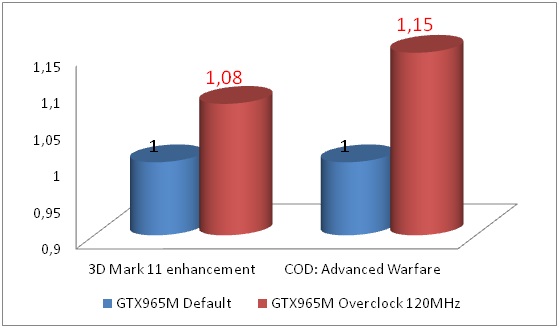
P.S. More detailed instructions for overclocking video cards with using MSI Afterburner is located in the MSI forum itself at this link:







